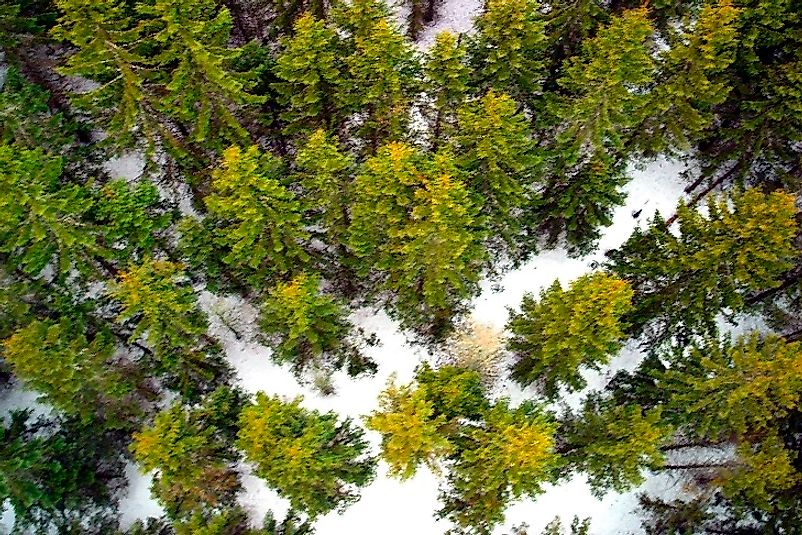Habitats And Ecosystems In Poland

Poland is a country in Central Europe with a total area of 312,685 square kilometers, making it around twice the size of the U.S. state of Georgia and slightly smaller than the U.S. state of New Mexico. The country is one of the European countries with a relatively rich biodiversity. The country also has a relatively low level of industrialization compared to other European countries, a situation which has facilitated the conservation of its flora and fauna. The Baltic Sea Coast, Carpathian Mountains and mixed forests of Poland house its native flora and fauna.
6. Carpathian Montane Conifer Forest-
The Carpathian Montane Conifer Forest ecoregion encompasses the Carpathian Mountains in Poland. The forest is characterized by the conifer trees, which thrive in the cold temperatures of the mountains. The climate of the region is moderately cold and humid on average and precipitation and temperature change with elevation. Fauna in the area include the European bison, lynx, brown bears, wolves and the wild cat. Tourism activities, logging, and air pollution have been identified as threats to the ecoregion's sustainability.
5. Central European Mixed Forest -
The Central European Mixed Forest is characterized by a mixture of deciduous and coniferous trees. Pine, oak, and beech trees abound in the area. The Scots pine species is the most dominant tree in the region. Annual rainfall in the region falls between 500 and 700 millimeters while mean annual temperatures range from 7 to 9 degrees Celsius. The forests provide a habitat for a variety of fauna, most of which are endangered. The European bison, bears, wolves, lynx and the black grouse are present in the region. In the ecoregion lies the Bialowieza National Park in Poland which was established to preserve the area's unique flora and fauna. Much of the ecoregion has however been degraded in place of agriculture and human settlements.
4. Baltic Mixed Forest -
The Baltic Mixed Forests ecoregion is classified as part of the Temperate Broadleaf and Mixed Forests Biome. The region is dominated by the sub-montane beech and mixed beech forests, alongside oak, sycamore, maple, and ash trees. The forest is found in the northern parts of Europe, specifically in the countries of Germany, Poland, Denmark, and Sweden. The ecoregion has been listed as critically endangered mainly due to human encroachment.
3. Baltic Sea Northeast Atlantic Shelf Marine -
The Baltic Sea Northeast Atlantic Shelf Marine is a marine ecoregion in the Baltic Sea, which links the country with the Atlantic Ocean. The ecoregion is home to an abundance of marine life. Whale species such as the Beluga whale, Blue whale, Minke Whale, Bowhead Whale, and Killer Whale are found in the ecoregion. The Atlantic puffin, Porbeagle shark, Capelin, Grey seal, and Arctic char are found among the various marine fauna present in the ecoregion. The ecoregion has been listed as critically endangered, with the major environmental threats being excessive fishing and pollution. Different projects have been initiated in the Baltic Sea to map the marine biodiversity in a bid to conserve marine the life.
2. Habitats and Biodiversity -
Poland is home to nearly 35,000 animal species and around 28,000 fungi and plant species. Of all the animal species, 700 of them are vertebrates, and over 100 of these are endangered. Small scale agriculture characterizes most parts of Poland, and this has helped, in part to sustain indigenous crop and animal species. Poland has the largest European populations of the European bison and the aquatic warbler.
1. Environmental Threats and Conservation Efforts -
Poland's ecosystems face a number of environmental threats. Pollution of the country's waters through dumping of chemicals and seeping in of pesticides is a significant threat to the country's marine life. Habitat loss, environmental pollution through the release of toxic gasses, rapid industrialization of the country's agricultural forests and lands continue to threaten the sustainability of Poland's flora and fauna. The country has been actively involved in conservation efforts. Through specialized environmental agencies, national parks, and reserves have been established and continue to be efficiently managed in Poland. Constant monitoring is also carried out in the country to determine the environmental status of various flora and fauna.











